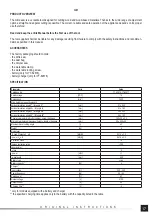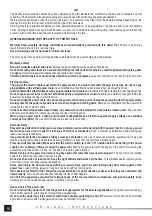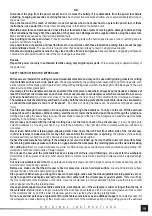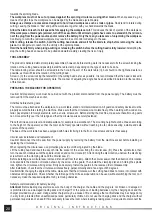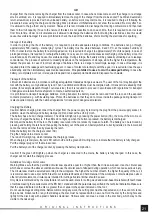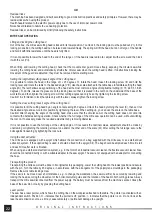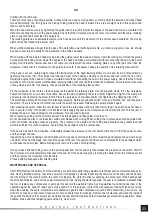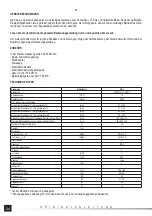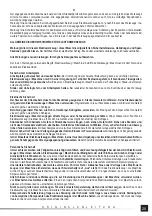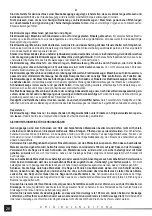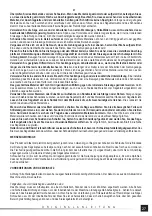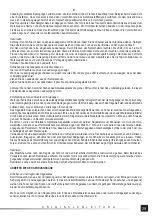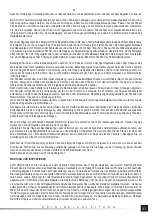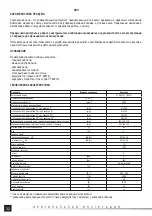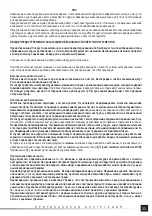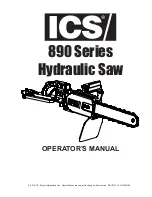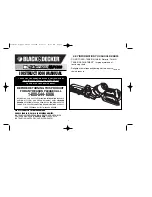
18
GB
O R I G I N A L I N S T R U C T I O N S
The declared noise emission values have been measured using the standard test method and can be used to compare one tool
to another. The declared noise emission values can also be used for preliminary exposure assessment.
Warning! Noise emissions during the correct operation of a power tool may diff er from the declared values depending on the
manner in which the tool is used, in particular the type of the workpiece.
Warning! Operator protection measures must be determined based on an approximation of exposure under current conditions
of use. All stages of the work cycle must be taken into account. In addition to the working time, other factors must be taken into
account, such as the time when the tool is switched off and when it is idle.
GENERAL WARNINGS FOR THE SAFETY OF POWER TOOLS
Warning! Read all safety warnings, illustrations and specifi cations provided with this power tool.
Failure to do so may
result in electric shock, fi re or serious injury.
Keep all warnings and instructions for future reference.
The term “power tool” used in warnings applies to all tools driven by power both wired and wireless.
Workplace safety
Keep the workplace well-lit and clean.
Disorder and poor lighting can be causes of accidents.
Do not work with power tools in an environment with an increased risk of explosion, containing fl ammable liquids, gases
or vapors.
Power tools generate sparks that can ignite dust or fumes.
Children and third persons should not be allowed to enter the workplace.
Loss of concentration can result in loss of control.
Electrical safety
The plug of the electric cable must match the power socket. You must not modify the plug in any way. Do not use any
plug adapters with earthed power tools.
An unmodifi ed plug that fi ts the outlet reduces the risk of electric shock.
Avoid contact with earthed surfaces such as pipes, radiators and coolers.
Grounding the body increases the risk of electric shock.
Do not expose power tools to contact with atmospheric precipitation or moisture.
Water and moisture that gets inside the
power tool increases the risk of electric shock.
Do not overload the power cable. Do not use the power cord to carry, pull or unplug the power plug from the power outlet.
Avoid contact of the power cable with heat, oils, sharp edges and moving parts.
Damage or entanglement of the power cord
increases the risk of electric shock.
In the case of working outside closed rooms, use extension cords intended for work outside closed rooms.
The use of an
extension cord adapted for outdoor use reduces the risk of electric shock.
When using a power tool in a humid environment is unavoidable as a protection against supply voltage use a residual
current device (RCD).
The use of RCD reduces the risk of electric shock.
Personal safety
Stay alert, pay attention to what you do and keep common sense while working with the power tool. Do not use a power
tool when you are tired or under the infl uence of alcohol or medication.
Even a moment of inattention while working can
lead to serious personal injury.
Use personal protective equipment. Always wear eye protection.
The use of personal protective equipment such as dust
masks, anti-slip safety shoes, helmets and hearing protection reduce the risk of serious personal injury.
Prevent accidental operation. Make sure that the electric switch is in the “off ” position before connecting to the power
supply and / or battery, lifting or moving the power tool.
Moving the power tool with the fi nger on the switch or powering the
power tool, when the switch is in the “on” position can lead to serious injuries.
Before turning on the power tool remove any keys and other tools that were used to adjust it.
The key left on the rotating
parts of the power tool can lead to serious injuries.
Do not reach and do not lean too far. Keep the right attitude and balance all the time.
This will allow easier control over the
power tool in case of unexpected work situations.
Dress accordingly. Do not wear loose clothing or jewelry. Keep your hair and clothing away from moving parts of the
power tool.
Loose clothing, jewelry or long hair can be caught by moving parts.
If the devices are fi tted for the connection of dust extraction or dust collection, make sure that they are connected and
used properly.
The use of dust extraction reduces the risk of dust hazards.
Do not let the experience acquired from frequent use of the tool resulted in carelessness and ignoring safety rules.
Carefree action can cause serious injuries in a fraction of a second.
Use and care of the power tool
Do not overload the power tool. Use the power tool appropriate for the selected application.
The right power tool will pro-
vide a better and safer job if used according to the designed load.
Do not use the power tool, if the electric switch does not allow switching on and off .
Power tool, which cannot be controlled
by means of a power switch is dangerous and must be returned for repair.
Summary of Contents for YT-82816
Page 33: ...33 RUS residual current device RCD...
Page 34: ...34 RUS 100...
Page 35: ...35 RUS 100 II X...
Page 36: ...36 RUS III IV V 45 Li Ion 10 20 500 0 30 50 70...
Page 37: ...37 RUS XX XX 48 EN 847 1 VI...
Page 38: ...38 RUS VII 45 VIII IX 0 15 22 5 31 6 45 45 X XI XII 45 O I XIII XIV...
Page 39: ...39 RUS XV XVI XVII XVIII XIX 0 3...
Page 41: ...41 UA residual current device RCD...
Page 42: ...42 UA 100 100...
Page 43: ...43 UA II X...
Page 44: ...44 UA III IV V 45 Li Ion 10 20 500 0 30 50 70...
Page 45: ...45 UA XX XX IV V VI VII VIII 45 48 EN 847 1...
Page 46: ...46 UA VI VII 45 VIII IX 0 15 22 5 31 6 45 45 X XI XII 45 O I...
Page 47: ...47 UA XIII XIV XV XVI XVII XVIII XIX 0 3...
Page 129: ...129 GR RCD RCD...
Page 130: ...130 GR 100 mm...
Page 131: ...131 GR 100 mm...
Page 132: ...132 GR X III IV V 45 LED XX XX LED LED LED...
Page 133: ...133 GR LED 48 EN 847 1 VI VII 45 VIII IX 0 15 22 5 31 6 45 45 X...
Page 134: ...134 GR XI XII H 45 O I X II XIV XV XV XVII...
Page 135: ...135 GR XVIII X 0 3 MPa...














